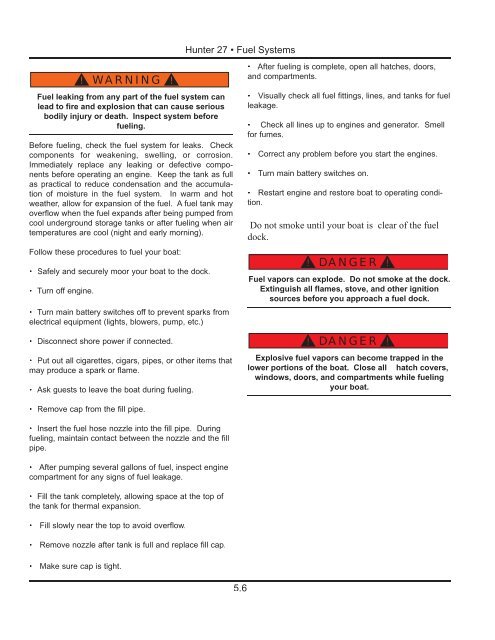27 Operator's Manual.. - Marlow-Hunter, LLC
27 Operator's Manual.. - Marlow-Hunter, LLC
27 Operator's Manual.. - Marlow-Hunter, LLC
Create successful ePaper yourself
Turn your PDF publications into a flip-book with our unique Google optimized e-Paper software.
<strong>Hunter</strong> <strong>27</strong> • Fuel Systems<br />
! WARNING !<br />
Fuel leaking from any part of the fuel system can<br />
lead to fire and explosion that can cause serious<br />
bodily injury or death. Inspect system before<br />
fueling.<br />
Before fueling, check the fuel system for leaks. Check<br />
components for weakening, swelling, or corrosion.<br />
Immediately replace any leaking or defective components<br />
before operating an engine. Keep the tank as full<br />
as practical to reduce condensation and the accumulation<br />
of moisture in the fuel system. In warm and hot<br />
weather, allow for expansion of the fuel. A fuel tank may<br />
overflow when the fuel expands after being pumped from<br />
cool underground storage tanks or after fueling when air<br />
temperatures are cool (night and early morning).<br />
Follow these procedures to fuel your boat:<br />
• Safely and securely moor your boat to the dock.<br />
• Turn off engine.<br />
• Turn main battery switches off to prevent sparks from<br />
electrical equipment (lights, blowers, pump, etc.)<br />
• Disconnect shore power if connected.<br />
• Put out all cigarettes, cigars, pipes, or other items that<br />
may produce a spark or flame.<br />
• Ask guests to leave the boat during fueling.<br />
• After fueling is complete, open all hatches, doors,<br />
and compartments.<br />
• Visually check all fuel fittings, lines, and tanks for fuel<br />
leakage.<br />
• Check all lines up to engines and generator. Smell<br />
for fumes.<br />
• Correct any problem before you start the engines.<br />
• Turn main battery switches on.<br />
• Restart engine and restore boat to operating condition.<br />
Do not smoke until your boat is clear of the fuel<br />
dock.<br />
! DANGER !<br />
Fuel vapors can explode. Do not smoke at the dock.<br />
Extinguish all flames, stove, and other ignition<br />
sources before you approach a fuel dock.<br />
! DANGER !<br />
Explosive fuel vapors can become trapped in the<br />
lower portions of the boat. Close all hatch covers,<br />
windows, doors, and compartments while fueling<br />
your boat.<br />
• Remove cap from the fill pipe.<br />
• Insert the fuel hose nozzle into the fill pipe. During<br />
fueling, maintain contact between the nozzle and the fill<br />
pipe.<br />
• After pumping several gallons of fuel, inspect engine<br />
compartment for any signs of fuel leakage.<br />
• Fill the tank completely, allowing space at the top of<br />
the tank for thermal expansion.<br />
• Fill slowly near the top to avoid overflow.<br />
• Remove nozzle after tank is full and replace fill cap.<br />
• Make sure cap is tight.<br />
5.6

















